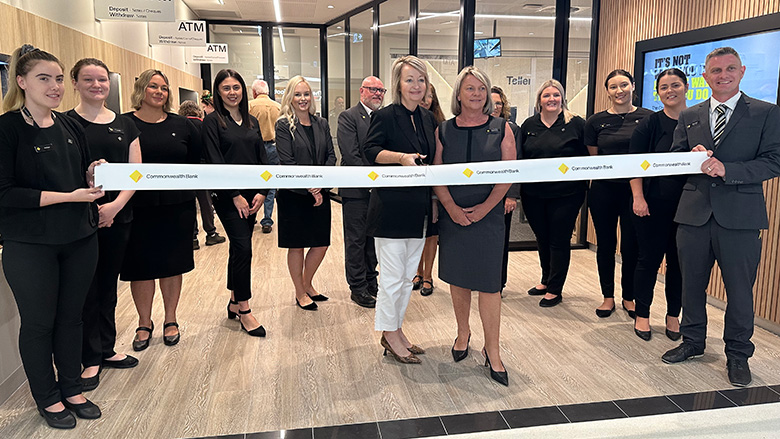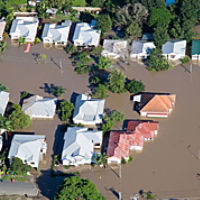This article is from the first issue of CommBank's magazine, Brighter.
The city of Lismore in NSW’s Northern Rivers region is often celebrated as the “rainbow” region, a moniker that sums up its colourful arts and music scene, and its friendly locals.
But in 2022, Lismore took a huge hit. Catastrophic floods in February and March resulted in loss of life, damage to more than 1600 homes and the displacement of more than 2000 people. At the height of the floods, more than 250 billion litres of water – enough to half-fill Sydney Harbour – flushed through the river system, collecting everything in its wake.
One year on, Lismore’s residents are tirelessly working to rebuild their lives and the town itself. Here, four locals share their stories of courage and community.
 Flood damaged buildings in Lismore, NSW, Australia
Flood damaged buildings in Lismore, NSW, Australia
East Lismore resident Crystal Lenane and her family – husband Frank Flannigan, their two children, Frank, six, and Ruby-Lou, four, and their dog, Jess – were rescued from their home by Lismore’s “tinnie army”.
“Everything was a panicked blur. As the waters rose in our home that morning, we stuffed what we could into one backpack for each member of the family and scooped up our dog. You don’t really have time to think about sentimental items; you’re focused on getting your family to a safe place. The tinnie army came just in time. As we were being rescued, I could hear other people screaming from inside their homes. I’ll never forget that sound or the ferocity of the water. On our street, it hit the four-metre mark, three metres above what Lismore experienced in the 2017 floods.
The tinnie army was just one example of how the residents of Lismore and East Lismore came together in the aftermath of the floods. A local family we didn’t know very well was kind enough to put us up for a couple of weeks and in town, community-led services such as Koori Kitchen and Sophia’s Kitchen kept everyone fed with home-cooked meals. Even when we returned to our home and began to clean up, we were rarely alone. Friends helped and so did strangers, whether it was cleaning up mud, dropping off essential supplies or popping by with sandwiches. When people ask ‘Why don’t you leave?’, I point to how special the community is here. That’s something you’d never want to leave.
“When we returned to our home we were rarely alone. Friends helped and so did strangers.”
One year on, we’re living in a caravan under our home as we work to rebuild. So far, we’ve put in temporary wall sheeting to create bedrooms and rebuilt our deck and stairs but building costs have doubled in the past 12 months, there’s a backlog in sourcing supplies and we’re trying to do everything ourselves on a small budget. We’re working hard to get life on track but there’s still a long, tough road ahead of us. We feel like we’re only at the beginning of our rebuild journey.”
 Flooded streets in Lismore, NSW, Australia
Flooded streets in Lismore, NSW, Australia
Long-time Lismore resident Andrew Parry, deaf from birth, lives alone and was rescued from his home by a friend.
“I’ve lived in the same house for 22 years and I’ve always felt safe. Lismore’s the kind of place where neighbours look out for each other and people take the time to sit down and have coffee together. This time, I began feeling worried because I could see it was raining a lot but I didn’t realise how bad things were until a friend came around to get me. I was lucky I got out when I did; in the morning the only thing you could see of my house was the ridge capping. Everything else was under water. I remember looking around that day and everyone was just so sad.
“Lismore’s the kind of place where neighbours look out for each other.”
At first I went to the evacuation centre with hundreds of other people, which scared me – Auslan [Australian Sign Language] interpreters were absent in emergency services announcements – but then I was lucky enough to have friends put me up. I stayed two months here and a month there before a caseworker from Uniting loaned me a caravan so I could live on my property while I worked on the house. It was a strange time; volunteers were in my house to help with cleaning but I struggled to tell them that they were throwing many of my memories away, too. But good things happened, as well. My friend Lara was able to take and clean all of my carpets and we kept a square of my horsehair plaster ceiling to get framed. Plus, there was plenty of food and cleaning tools in town provided by Koori Kitchen and the Koori Mail.
I’ve been able to access various government grants and payments to rebuild my home and I’ve been given vouchers from companies like Bunnings and Officeworks. What’s really helpful are the services from Deaf Connect, which organised for people to come in and take off my walls, and the Two Rooms Project [a volunteer-led initiative run by Resilient Lismore to build two rooms in flood-damaged homes]. I’m getting two rooms built that I wouldn’t have been able to afford myself. In Lismore people go the extra mile to look after their community members. It really makes a difference.”
 CommBank's Stephanie Darragh had to temporarily move her branch into a shipping container
CommBank's Stephanie Darragh had to temporarily move her branch into a shipping container
When Stephanie Darragh first accepted the position of Lismore CommBank branch manager, she couldn’t have predicted just how much she’d be able to help her community.
“One of the things I miss the most is driving through town with the windows rolled down to absorb its buzz. After the 2017 floods, we’d just gotten ourselves to a point where we’d not only rebuilt the town physically but emotionally. New businesses were opening, people were spending and there was an upbeat vibe you felt proud to be a part of. When the 2022 floods hit and the waterlogged streets became increasingly narrow and mountainous with household debris, I could see the magnitude of the damage but I knew before I even went into the branch that the town’s vibrancy would take the biggest hit.
“Some days we had to rely on word of mouth to communicate with our customers.”
Our branch went completely under but right away we were able to obtain a shipping container to work out of. Conditions weren’t easy – a second flood in March meant we had to temporarily move the container out of town to avoid damage and many customers weren’t receiving our messages because they’d lost their phones and computers. Some days we didn’t even have service in the area and had to rely on word of mouth to communicate with our customers. Working in the shipping container was tough, particularly on some of those 40 degree days but I was so proud of my team. Many of our members were directly affected by the floods; nevertheless they put boots on the ground every day to help others. It made me realise it wasn’t only the town’s vibrancy I was attracted to but the community’s love and care for one another in a time of need.
We did what we could for flood-affected residents, from stopping loan repayments to offering interest-rate reductions for homeowners. People have been through an awful lot; there’s a high percentage of job loss and frustration about the time it’s taking to get insurance payments and government grants through to those who have been affected. I get it. That said, we opened our new branch in December – it’s bright, welcoming and is an environment that can make a difference to people who walk through the doors. My favourite thing is when people say to me, ‘Everyone’s smiling and that’s a lovely thing to see.’ Happily, I’m hearing that a little more these days. Give us a bit of time and I’m convinced Lismore will come back better than ever.”
 Resilient Lismore
Resilient Lismore
Elly Bird, executive director of Resilient Lismore, has helped coordinate the community response to the floods. And she was a Community Hero finalist in the 2023 NSW Women of the Year Awards.
“There’s so much to love about Lismore. I could talk about its location, the beauty of its landscape and the diversity of experience that can be found here. The flipside, of course, is that it’s also prone to flooding and since 2017 we [first as Helping Hands Lismore then, since 2022, as Resilient Lismore] have been instrumental in amplifying messaging around disaster preparedness on social media in line with emergency warnings.
“What drives you to keep going is a passion for getting your people into safe and secure housing.”
When the 2022 floods first hit, I knew the recovery period ahead of us would be lengthy, complex and traumatic. It was imperative to first ensure that people who were using social media were getting timely and accurate information but at the same time I knew we had to plan for the community response once the waters went down. The logistics behind coordinating our response were significant; thousands of people poured into the community to help and well-intentioned people from all around the country sent – or drove over – trucks of donated goods. There were warehouses to establish, network meetings to conduct, media interviews to raise awareness of the community’s plight and connections between services and volunteers to create. I worked 60-hour weeks for the first six months but what drives you to keep going is a passion for getting your people into safe and secure housing as quickly as possible.
It’s lovely to receive recognition for the work I’ve been doing but it’s important for me to shine a light on the fact that we still have a long way to go. Volunteers get burnt out and with disasters of this scale we need everyone – government, the private sector and private citizens – playing their part. It would be a huge help to properly fund communities so they can do this kind of community support network and it needs to be more than a conversation about community members lending a hand. We can do better and we can think bigger.”
Story by Dilvin Yasa.
Read more articles from Brighter magazine.



